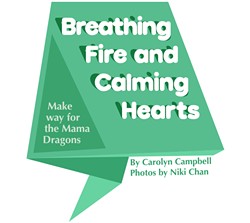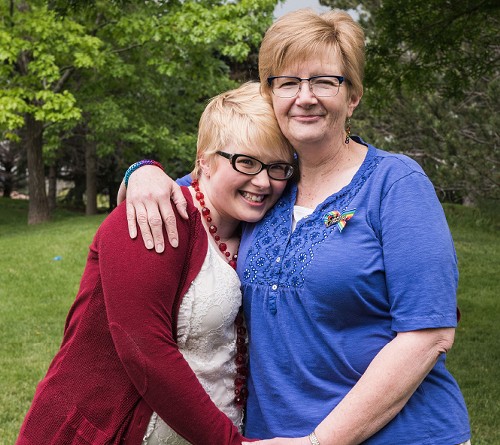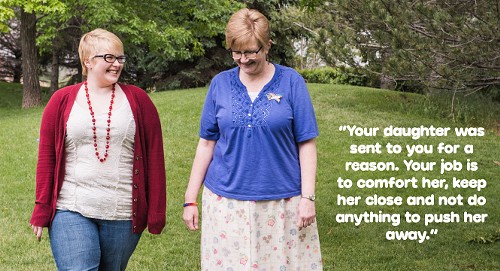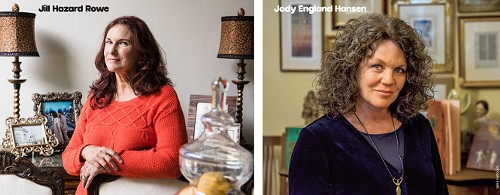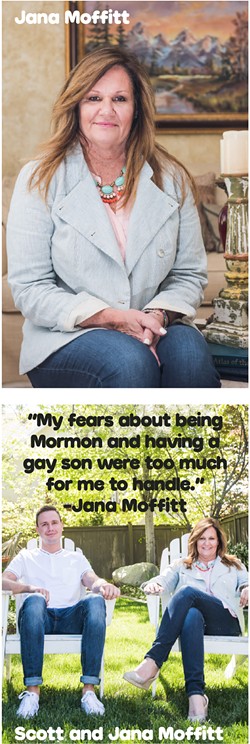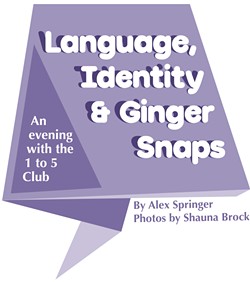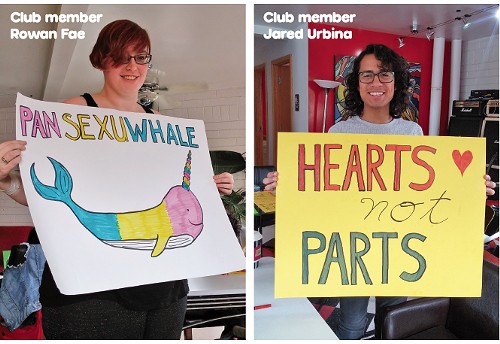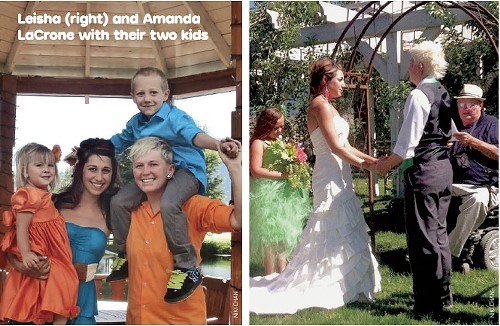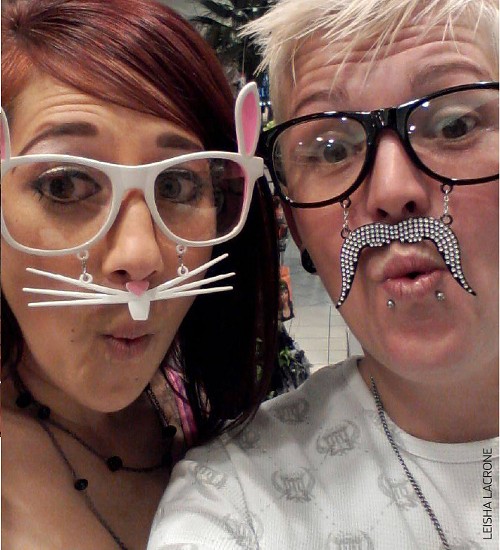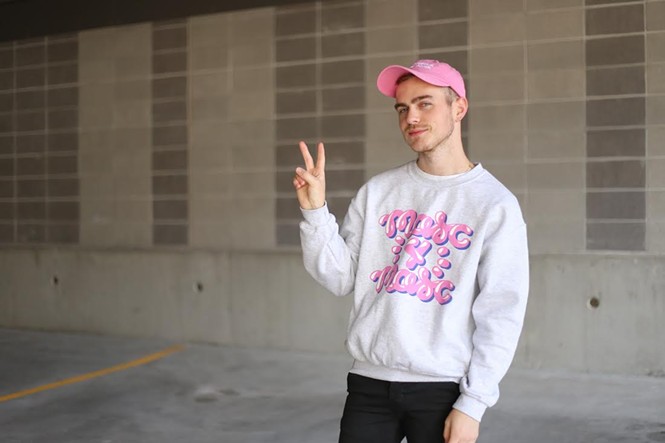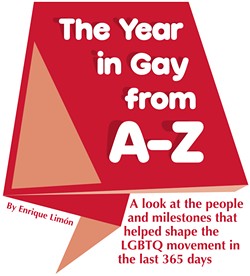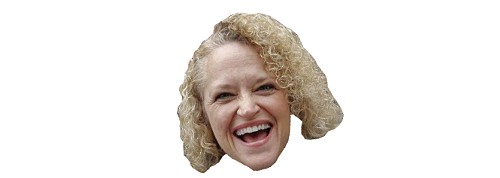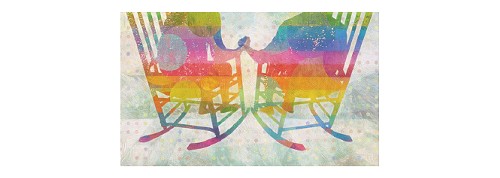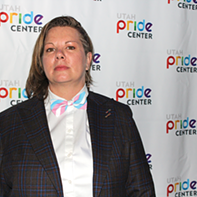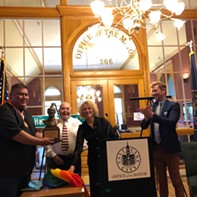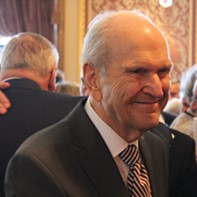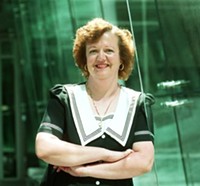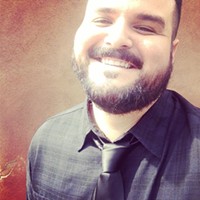
Proud
The Pride issue 2016
By Carolyn Campbell, Alex Springer @captainspringer, Doug Lowe, Kylee Ehmann and Enrique LimónAs a member of the LGBTQ community, it's been a long road to the current days of #slay and YASSS GAGA. Like many of my cohorts in the Beehive State, being proud of being different wasn't intrinsically in the cards for me. In fact, I remember my nighttime routine growing up involved getting down on my knees and praying to God to make me "normal." To be OK with being different, and on top of that to celebrate it, seemed like lunacy.
Still, eventually, celebrate it I did. For me, Pride festivities represented an opportunity for park-drinking, manic dancing and daytime scandal. After a few goes at it, I saw past the beads and the balloon-adorned flatbeds, and came across its true meaning: pride in your community and pride in oneself.
That feeling reached its zenith last summer when a landmark Supreme Court decision made marriage for all the law of the land. A lot of people altered their Facebook profile picture to one emblazoned with the colors of the rainbow flag, remember that? Up until then, the sigil—the work of San Francisco artist Gilbert Baker—meant very little to me. It was a mere symbol often seen on shot glasses or cheap dog tags in San Diego's Hillcrest district where I'd come into my own. But on the evening of June 26, it meant triumph. It meant vindication. It meant unity, as many non-gay friends also changed their profile pic in support.
That same jubilation continues to run deep in Utah thanks to some of the subjects featured in this special issue. People like illustrator Andy Simmonds, aka Hey Rooney!, who has amassed a huge social media following thanks to his clothing line that challenges gender norms. There's also the Mama Dragons, a group made up entirely of LDS women that whole-heartedly support their LGBTQ kids. They started out as a secret a few years back and are now a fiery and open force to be reckoned with.
For many, a year lead time is barely enough to plan a wedding. Luckily, Amanda and Leisha LaCrone had the better part of a decade to plan theirs and become the first same-sex couple to marry in Sanpete County. And what about the often-overlooked bisexual community? Yep, they do exist and they meet up on the regular. Find out what they're all about here. Finally, we celebrate with cheers and jeers the ups and downs of the year gone by.
As far as my own journey goes, when I pray now, it's usually to give thanks for the family and friends I've been blessed with; and about the only change I ask for is a change of heart in those that continue to ostracize, vilify and spread misinformation about those like me. I also give thanks for being different, because let's face it, anything else would be wearisome.
This is my new normal, and I've grown to embrace it, unabashedly love it and be 100 percent proud of it.
—Enrique Limón
Breathing Fire and Calming Hearts
Make way for the Mama Dragons
By Carolyn Campbell
Photos by Niki Chan
Mama Dragons began with eight LDS women private messaging each other on Facebook. Co-founder Jill Hazard Rowe recalls that a woman in American Fork sought help for a student in a gay-straight alliance who was having issues. "She brought in a few of us to answer questions." They supported that student and the feed continued. "It became a nightly thing with us, sharing our sorrows and pain, not only about kids, but also about our church." It was a place to vent where the women felt truly safe, where their sisters had their backs. The thread of private messages became so long that they created the Mama Dragons Facebook page and added people. They continued to offer support for other LDS people navigating the waters of LGBTQ issues within their families and communities. Initially, the Facebook setting was "secret." Then they realized how much support is needed and that people are looking for help. Today, there are nearly 900 women worldwide. The group has expanded to include other faiths. "We respect everyone's spiritual journey," says Rowe. The name Mama Dragons originated when an Arizona mom decided that the term "mother bear" wasn't powerful enough. In Mama Dragon Story Project, she explains that, after her 13-year-old son came out as gay, "a whole new level of protection came over me. I now call myself a Mama Dragon. I could literally breathe fire if someone hurt my son."
Lisa Glad
Four years ago, the bottom of Lisa Glad's world suddenly dropped away. It was Dec. 22, the night before her big family Christmas party. She and her 20-year-old daughter, Patti, sat alone in a Lowe's parking lot. Patti suddenly said, "Mom, the thing with this girl tonight ... it's a date. I'm lesbian." Glad's mind rushed helplessly as she thought, "I don't know what to do with this." Aloud, she said, "I don't want to lose you. I love you. We will do whatever we need to do." She reassured Patti that she would not disown her, adding, "You are mine and you will always be mine." Glad survived the holidays because she didn't have time to talk to anyone. Then she contracted a bad case of the flu. "I welcomed it. I could hide in my room," she recalls. She made an appointment with a family friend who was also her family doctor and her parents' LDS bishop. "I went in to see him and just fell apart," she says. He reassured her, saying, "Your daughter was sent to you for a reason. Your job is to comfort her, keep her close and not do anything to push her away." Glad bore that message in mind years later when her youngest daughter, Kris, expressed that she wasn't transgender, but didn't feel female, either. Today, she identifies as asexual and gender-queer.
Glad is validated by reaching out as a Mama Dragon. "Our main focus is being allies to each other as mothers. By supporting each other, we can support our gay kids and everybody else's. Finding out that you have a gay kid can rock you to the core. It's my opinion that those parents are the ones who the Savior would reach out to the most." She has two equally strong testimonies—one of LDS Church teachings that she feels "are absolutely right" and the other that advocating and helping parents of LGBTQ children is the absolute right thing for her to do. "I've told my stake president about the conviction I have that I am called to this. If I had to choose between my activism and love for my kids versus the church, there is no question that my kids would win. I don't want it to come to that ultimatum." She's currently a nursery leader in her LDS ward. "I know there are certain things in older classes that I cannot teach." She supports her daughters' decision to leave the church because "negative things they have heard their whole lives have contributed to their anxiety and depression. Heavenly Father has reassured me that he will keep his arms around my girls. There are times when I want to leave the church, too. Then the spirit tells me I need to be there."
She attended the Mama Dragons second retreat held at a huge home in St. George that once belonged to a polygamist. "There were bedrooms with individual bathrooms all around the perimeter of the house." After she posted photos on Facebook, her daughter, Patti, asked her to send her a photo of the kitchen. Then she called her mom to say that she had been to that house, too, for a college seminar. "That is the same house where I told someone I was a lesbian for the first time," she said. That coincidence further brought home to Glad that "this work is what I need to be doing. Mama Dragons helps me reach out to moms to tell them that if they keep breathing and loving their kids that everything will be all right."
Jill Hazard Rowe
On Nov. 6, 2011, Jill Hazard Rowe's son, Hunter, came out as gay. Hearing his words, she began to cry. She mourned the loss of everything she imagined would happen in his life, including marriage and a mission. Rowe's own history in the LDS church included serving a mission, temple marriage, teaching seminary, serving as Relief Society president and working with Young Women. "I had many spiritual experiences and we raised our six children in the gospel. But when my son came out to me and my husband, I knew I needed to get rid of everything that I previously thought. I realized I was taught by my leaders, but had never taken it to God."
She learned that while being gay is hard, "being a gay Mormon is impossible. The sooner we as a faith community accept and love these kids, the sooner we will stop the suicide rate." She says that while "Hunter was happy to be in the family setting, he didn't connect with church and school. He was very much a loner." Then he began to dance in his senior year of high school. "He just fell in love with dance as a way to express himself." Today, Hunter dances and choreographs with a dance company in Denver. "I saw this light in his eyes after he came out to us. Through dance, he became a new person. He started to build confidence and accept that he has worth and meaning." Because of her strong spiritual experiences, she chooses to stay in the LDS Church at this time. "I walk in those doors every Sunday hoping to make a difference. My religion has boiled down to love more, judge less. I pray for the day when my son can walk into church and be embraced, have a calling and have his fellow Saints support him in that. I pray for the day when he chooses to marry and have a partner and children to raise. I hope they can be in the Mormon Church and be welcome. If this is Christ's church, he would want all of his children to sit in the pews."
A Mama Dragons board member, her passion is connecting with women and making sure they are not alone. She looks forward to attending the third annual Mama Dragons retreat, where women come from across the country. "We spend a week together, where we hike, talk and connect with each other. As you move along this journey, you become more settled. In the beginning, I cried for a month. I have humor now."
Jody England Hansen
Hansen says the thing she regrets most about the time when her 17-year-old son came out was that she initially made it all about her. "When he came out, I thought, 'wait a minute. This can't be true.' I wondered why I didn't know about this. I had no idea, even with friends and loved ones who are gay." Hansen is a ninth-generation Mormon. Her father was Eugene England, a well-known LDS writer who founded Dialogue, a quarterly printed and online "journal of Mormon thought." "The church had been the air that I breathe forever," she says. After her son came out, she had many days of pleading, praying and despairing. "I regretfully and painfully admit that I thought it would be best to try to keep him within what I thought could be a supportive structure of the church community—until I was finally willing to see how often he was hearing the messages of 'we love you, but ... you are inherently wrong, unnatural, unworthy, you will never be accepted by God, you need to change.'" She felt that these messages overwhelmed the gospel message "that God loves all of us, now, as we are, and we are to love one another." Today, her son is no longer involved in the church. She says, "One blessing of having a child who does not fit within our idea of tradition or culture is that you open up to see that every single path is individual and can lead to God."
For months, she pleaded with God to give her answers. One day, in a contemplative silence, she felt a prompting that said, "Ask a different question." In her mind, she asked God, "Is he yours?" She says that love flowed around over and through her. As she opened her eyes, she expected to see a tangible manifestation of the love that she felt. "We spend so much time and energy talking about what is going to happen after this life," she says. "The one sure thing for me is that this life is about loving each other. If we can't do that, nothing in the next life will make a difference."
Jana Moffitt
For years, Jana Moffitt kept her worries that her son might be gay "deep down, in quiet, secret places." My fears about being Mormon and having a gay son were too much for me to handle," she recalls.
From the time he was about three years old, she noticed that Scott was different from his three older brothers, preferring to hang out with his sister rather than following the activities of the older boys. When he was around 13, Scott began spending a lot of time at home, in the basement.
His sister came to Moffitt, unnerved by pictures she found on the downstairs computer. "They were male physiques—body builders. You could tell these guys were gay," Moffitt says.
At that moment, her fears of her son being gay became an urgent reality. She questioned Scott, asking, "Is this who you are?" Two days later, he said he had known for a long time. "He was scared to death to be gay," she says.
An LDS bishop suggested therapy. Because Scott was scared to even sit in a waiting room for fear that someone would see him, Moffitt drove him to Provo therapists. "I sneaked him to Provo for years. My other kids didn't know. I made up stories about going to a piano recital or a workshop for school," she says of the nearly six years of therapy.
"The therapy didn't accomplish anything dramatic. He said it did help with his self esteem." Scott went on an LDS mission and returned eight months later. "It wasn't a good experience for him. But once he came home, he told his siblings he was gay. They love him and were all supportive," she says.
Scott found himself at the University of Utah, where he made friends who were in the arts and music fields that he also enjoyed. He was also involved in student government. Scott started telling a few friends, with whom he felt safe, that he was gay. He decided that he would come out after college.
"I could hardly wait for that time, so that I would be able to talk to somebody, to finally say that I have a gay son. I desperately needed someone who could understand my feelings," Moffitt says. A friend referred her to Mama Dragons. She says that they are still her best friends today.
She usually sees another Mama Dragon weekly, or at least twice a month. She is struggling to reconcile her acceptance of her son with the policies of the LDS Church. "I am mourning the loss of a religion I had dedicated my life to. All the things I was taught about the pre-existence and the celestial kingdom have had to change. I can't believe my son won't be with me wherever we are."
Today, she says Scott is "the happiest boy" as he prepares to attend graduate school at Duke University to pursue a career as a physician's assistant.
Language, Identity & Ginger Snaps
An evening with the 1 to 5 Club
By Alex Springer
Photos by Shauna Brock
Family is a term that used to be strictly tied to biology. As our society has evolved, however, this word has had the luxury of evolving right along with it. In fact, it's one of the few existing words that Salt Lake City's 1 to 5 Club can use to accurately define itself—the evolution of language has been unkind to those who don't identify as gay, straight, lesbian or transgender. The 1 to 5 Club is fighting an uphill battle, but this small family is up to something big.
Co-founded by Shauna Brock, the 1 to 5 Club holds bimonthly meetings at the Utah Pride Center to support one another and discuss issues surrounding the bisexual community. "The name comes from the historical significance of the Kinsey Scale, which ran on a spectrum of 0 to 6, with 0 being completely heterosexual and 6 being completely homosexual," Brock says. "Kinsey himself was a bisexual, which also ties back into the name of the club." Brock was prompted to help create the club because she was surprised to see that the B in LGBTQ didn't get a lot of representation in the larger community—the first Pride Festival that she attended was still called the Gay Pride Festival. "I felt erased, dismissed and censored," she says.
For those who maintain a cursory knowledge of the LGBTQ community's fight for equality, it might be hard to believe that a stigma of exclusion could exist within their own ranks. For decades, LGBTQ groups and movements have fought tooth-and-nail to get where they are today, and the fight is far from over. Based on that evidence, one would think that the bisexual community would have as much of a voice as that of the gay, lesbian and transgender. The reality is that those who identify as bisexual are often met with uncertainty and even derision within the communities that claim to be fighting for unconditional equality regardless of sexual identity. Many bisexuals expect the Pride Festival and the LGBTQ community to act as places of inclusion in a world that is still struggling to accept the concept of sexual fluidity. As the members of the 1 to 5 Club reported, that is seldom the case. This creates a disconnect that has, according to a study conducted by the San Francisco Human Rights Commission, resulted in elevated levels of depression, anxiety, poverty and domestic violence within the bisexual community.
The 1 to 5 Club exists as a refuge for precisely this reason. As we passed a package of gingersnaps back and forth, it was easy to see how such unexpected dissonance created a sense of alienation and frustration among the 17 people in attendance. Our discussion covered everything from the erasure of bisexuality among historical LGBTQ activists to the often-absurd legislation that is currently under scrutiny. Perhaps the most profound discourse that arose during the discussion was the inability that our language has to accurately define sexual fluidity, along with the consequential fallout. Since our legal system is based on that same imperfect system of communication, it makes legislation that impacts the bisexual community very murky and exclusive. "It was hard to hear our supporters argue that sexuality is innate and unchangeable to the Supreme Court," says club attendee Matt Conway, "According to the court, if there was any clear evidence that a person would change their sexuality or gender identity over the course of their life, then they couldn't protect that person." Joni Alexandria, a member of the 1 to 5 Club's sustainability committee, responded, "Being sexually fluid is innate, but how do you demonstrate that in court? So-called 'rational thinkers' require binaries—they need to put walls around things, and that is always problematic."
While legal language will always struggle to find a place for ambiguity, society's use of language becomes the biggest impediment to inclusion. A large percentage of bisexual or sexually fluid people struggle with their identities because they aren't armed with the right language to accurately describe themselves, which forces them to rely on the language that others would choose for them. Attendee Grayson Moore explained how this disconnect "shifts the emotional and mental labor to those who don't match the cultural default." When someone identifies as sexually fluid, they are often forced to rationalize their identity to others simply because it doesn't fit within the culturally accepted defaults of gay, straight, lesbian or transgender.
As an example, Brock shared a story about a 1 to 5 Club presentation that she was running for the Pride Center. She used the term "biromantic," which caused a woman in the audience to approach her. "I never understood why I was in love with my husband, but didn't want to have sex with him until you used those words," she said, "I divorced him and I'm happy with my partner now, but if I knew that term then, I would have been a hell of a lot more happy."
"Words are just words, and they're never going to work exactly the way we want them to," says attendee Lux Knudsen, "But if we give people the opportunity to learn from us, it gives us all an opportunity to grow." This is why the 1 to 5 Club is so important to the LGBTQ community. By raising awareness of the fact that a large part of the LGBTQ population is still struggling to accurately define their sexual identity, they are making an impact. The Utah Pride Center is one of the only national Pride Centers that provides support and budget for bisexual programs like the 1 to 5 Club, and their presence at this year's Pride Festival means that those who may be struggling to define their sexual identity have an inclusive resource that is dedicated to helping them—which is exactly what families are for.
They Did!
A tale of a marriage 10 years in the making
By Doug Lowe
Thanks to fate or luck after a 10-year delay in their relationship, Leisha and Amanda LaCrone made history on Christmas Eve of 2013 as the first gay couple ever married in super-conservative Sanpete County, Utah.
Their unprecedented union happened soon after a federal court ruling, on Dec. 20, 2013, that opened—very briefly—a window of opportunity for same-sex marriages in Utah. Sadly, some two weeks later, on Jan. 6, 2014, that window slammed shut. But, by then, Leisha, Amanda and a few other same-sex couples around the state had successfully jumped through it.
The U.S. District Court for Utah issued its decision legalizing same-sex marriage on a Friday. So, gay couples all over the state started anxiously waiting for Monday, when they could apply for their marriage license.
Leisha vividly remembers: "On Dec. 23, 2013, we hurried to the Sanpete County Courthouse in Manti for our marriage license." But there, they were told, "no." Leisha, while leaving empty handed, announced that she was going to sue Sanpete County for refusing to abide by the widely publicized and reported federal court ruling.
"A few hours later," Leisha recalls, "someone phoned, apologized and said we could be married the next morning. So, on Christmas Eve, we all went down to the courthouse and got married by the Sanpete County clerk."
That marriage had been 10 years in the making.
During Amanda's freshman year, at North Sanpete High in Mt. Pleasant, she first saw Leisha, who was a couple years older. "Instantly I had a crush on her," Amanda says, "and I said to myself something like, 'Oh, my goodness, who is this girl?'"
She learned that the "who" was Leisha LaCrone. But Amanda never got to know her. Being shy and unaware of her bisexuality, Amanda did not pursue her attraction. And when her then-boyfriend got her pregnant, she married him (but without the romantic proposal Amanda had dreamed of).
Leisha, on the other hand, came out in high school. "I didn't want to pretend anymore to be somebody I wasn't," she says. After graduating and turning 18, she and her girlfriend at the time started living together in the area.
Within a few months, however, Leisha moved to Salt Lake City, where she stayed for about six years, enjoying the city's larger and more diverse population. There, her life was good.
Meanwhile, back in Sanpete County, Amanda was struggling with her marriage. She recognized that in some ways her husband, the father of her two children, wasn't a really bad guy. Sadly, she also realized he wasn't such a good guy, either—at least, not for her, she says.
He wouldn't, or couldn't, appreciate certain things that were important to Amanda; for instance, the romantic proposal she never got. She asked him numerous times to propose, but he never did. And, for years she had asked him to fulfill another special dream by taking her to the ocean and beach at Santa Monica Pier. He never did.
Eventually, Amanda filed for divorce. And in the process of ending her loveless marriage, she suddenly crossed paths with Leisha again.
While stopped at the Sinclair gas station on Utah Route 89 in Mt. Pleasant, Amanda went inside to buy something. And there, behind the counter, as if waiting for her, was her secret high-school crush, Leisha LaCrone.
Even though it had been roughly eight years, seeing Leisha again immediately ignited the old flame. Though her heart pounded and the words didn't want to flow, she managed some small talk while making her purchase.
Amanda's visits to that gas station became more frequent, and the two women opened up to each other. Amanda learned that Leisha had an older sister who was also a single mother, and that she had moved back to Sanpete County because her sister needed help with the children.
Soon, the couples' visits turned into serious dating. And when Leisha learned that Amanda's soon-to-be-ex was not giving her any financial support with her two kids, Leisha suggested that they move in with her—along with her sister's three kids who were often there.
About that same time, Amanda and her kids left town for a few days on a road trip to visit her parents in Montana. The trip was a turning point in their relationship.
Not wanting Amanda to have to drive all the way back by herself, Leisha flew to Montana. Somehow, the return trip—with Leisha helping to drive and manage the two kids—cemented their love. "On that drive, I realized how much I loved Leisha," Amanda says. She came to clearly understand, "I had finally found somebody who actually cared about my life, who wanted to help make me happy."
And the trip was equally monumental for Leisha: "I saw Amanda being such a strong woman and such a great mother, that I fell in love with her." After that journey, Amanda and her two children moved in.
Come fall 2013, Leisha began secretly planning a trip that she hoped would fulfill two of Amanda's dearest unrealized dreams. But as far as Amanda knew, it was a trip to Las Vegas.
In fact, Leisha had two big surprises for Amanda. "I got a ring and I took her to the Santa Monica Pier at sunset on Oct. 18, and asked her to marry me," Leisha says. When Amanda responded "yes," the two started making plans to marry in the summer of 2014.
Unexpectedly, a little more than three months later, fateful legal machinations gave the couple a sudden opportunity to speed up their wedding plans. They jumped at that chance, and made a bit of history in the process. "Our marriage was front page news in the local papers, the Sanpete Messenger and The Pyramid," Leisha says.
The two were ecstatic about their marriage, as well as the support of family, despite association with the LDS Church. "We aren't trying to offend anyone among our Mormon neighbors," Amanda says. "My grandfather, who is the mayor of Fountain Green and an active member of the church, was happy to conduct the ceremony we held to celebrate our courthouse wedding."
Sanpete County residents like to call their mountain valley "the Heart of Utah." The double entendre refers the geographic center of the state (very close to where the LaCrones live), as well as the rich history behind the area's many picturesque pioneer-era homes, storefronts and LDS meeting houses (including the temple in Manti). Perhaps it also refers to those old-fashioned Mormon values, including refusal to judge others.
Today, that heart might also serve as a tribute to the momentous love story of two Sanpete County women who dared to marry each other—and were finally able to do it on Christmas Eve in 2013.
Rooney Tunes
Local illustrator challenges norms one bubble gum creation at a time
By Kylee Ehmann
Pastel pink, bubbled letters and rainbows are not usually on the list of things that count as subversive imagery.
But this overtly traditional feminine design scheme, coupled with phrases such as "Masc4Masc" written in loopy lettering and cutesy images of men in lingerie, is pushing back against traditional gender norms. Andy Simmonds, local illustrator and the creator of Hey Rooney! products, uses his artwork as a way to convey joy through this aesthetic, as well as playing with conventions of femininity and masculinity.
"Kind of how I view art, how I enjoy it and how I approach it, is just not that seriously," Simmonds says. "A lot of people have these really narrow expectations for what is art, and I think that's the point of art. ... You get to define it yourself and break that view in content or medium or whatever that might be. It's just not that serious."
Viewing art as something more fun than studious is fed by his past growing up in Bountiful, Utah. Rather than anything specific to the city or his family, he says experiencing the strict interpretations of gender roles in a conservative, Mormon-dominated culture made him question the seriousness of the gender binary, an attitude that funnels into his creative process.
"I think this goes for anyone in similar circumstances. Their gender roles are very enforced and there are limitations on what is acceptable for you to express as a male, or as a female," he says. "And after having come out, I felt very liberated, obviously, and that just translated into my artwork and design to kind of incorporate and play with masculinity, femininity—kind of poking fun at it, but also making some statements about it."
Simmonds says working and living in Utah provides a lot of inspiration for his artwork because he says he sees the amount of influence the Church of Jesus Christ of Latter-day Saints has on local politics. His work does not come from a place of anger, he says, but more from looking at his environment in a critical way.
Clearly his message has resonated as he's amassed quite the social media following. His Instagram account alone (@heyrooney) has close to 50,000 followers.
"I try to make a statement, but to do so in kind of a playful way that's hopefully not too heavy or serious," he explains. "I think it makes it more digestible for me. I do feel that it's important to take certain things seriously, but also to have a playful spin on it makes it feel easier to process and then respond to it."
Simmonds says he is continually responding to the images around him, as evidenced by his recent design, "Make America Femme Again," a bubblegum pink-and-white riff on the Donald Trump presidential campaign slogan. Every few of the ideas that he doodles and draws like this tend to ring true for him, and he runs with it from there, working and reworking an idea until it's ready to display.
"Sometimes it's really well-received and people kind of get the joke or whatever it might be, and sometimes it does not land and no one really cares," he says. "But regardless, I really enjoy being inspired by something."
And while the local social and political climate influences his artistic statements, it is the pop art of Keith Haring and Andy Warhol that heavily shape his bright, simple graphic artwork, and have since he was a kid.
"I'm a visual learner and I'm a visual communicator. So I'm drawn to that because it's the way that I guess I make sense of the world, or my own issues," Simmonds says. "It's a visual solution."
But now, he says, the images of Haring and Warhol hold a kind of power beyond aesthetic. While he was formerly unaware that both of these artists were gay, learning about their openness with their sexuality and their positive impact on the LGBTQ community now makes him value their artwork even more.
Growing up, the designer says, he was in an "intense denial" about his sexuality. His art functioned as a kind of pressure valve to work through his feelings at the time.
"Of course, I didn't see it then, but I look back and, especially at adolescent art, and there's such a gay subtext in there," he says. "Art allowed me to ... explore my sexuality in a way that wouldn't be monitored or questioned and that I think really, although I did not realize it at the time, was really beneficial to me."
Simmonds came out while attending Brigham Young University, where he began to focus on lettering and typography as art.
"Being gay at BYU was awful, point blank," Simmonds says. "You are allowed to be openly gay, beyond that, your experience does not go past that. One would feel very stifled—I did, and left very quickly."
Since leaving BYU, the self-professed "professional tween" has focused on expanding his art base, both in the number of people the art reaches, and in what and how he creates his work.
Specifically, he says, he would like to work more with painting and drawing on paper, as most of his work is currently digital-only. By doing so, he hopes to get his work into more physical spaces, such as an installation or a gallery, all while keeping his pastel and bubbly aesthetic.
"I love making cute, pink, pastel things, sure, but I would like there to be the depth that I feel and process things with," he says. "I would hope that is communicated in what I do and that people feel something deeper than just pastels and things that they feel is just speaking whether they relate to it or not."
Simmonds is currently working on a handful of designs that are a bit more serious in nature, but is keeping them under wraps for the moment as he is sending them out to other publications.
"I feel I've worked so hard and have gone so much to pursue authenticity and if nothing else I hope that's what someone would take out of my work—that they'd feel inspired to or empowered to pursue their authenticity regardless what that means to them," he finalizes.
The year in gay from A-Z
A look at the people and milestones that helped shape the LGBTQ movement in the last 365 days
By Enrique Limón
A is for allies. The LGBTQ community has won many battles, thanks to those nongay voices that have lent their heft to the cause—from the Senate floor to the classrooms of St. George's Snow Canyon High School. We wholeheartedly thank you.
B is for Jackie Biskupski, elected on Nov. 17, 2015. The jury might still be out on what the legacy of her term might be, but the fact remains that as Salt Lake City's first openly gay mayor and only the second woman ever to hold that post, she's broken new ground.
C is for criminalization. Homosexuality is still criminalized in 79 countries around the globe including Egypt, India, Singapore and Jamaica. Stateside, though anti-sodomy laws were ruled unconstitutional in 2003 by the U.S. Supreme Court, 13 states (including Utah) still have 'em in the books.
D is for dracarys and those Mama Dragons that stand by their children no matter what.
E is for elders. Those of the non-Mormon kind. Respect them. Acknowledge them. Talk to them. Bow down to them. Without those fearless badasses that paved the way (many of whom succumbed at the height of the AIDS crisis), your reality would be less fabulous.
F is for forty-one. Utah Pride might be middle-aged now, but trust me, it's never looked better (in that hot, salt-and-pepper daddy kind of way.)
G is for the gender nonconforming and trans* brothers and sisters. There's still a long way to go, but you give this vibrant community its diversity and transgressive might. #Masc4Masc be damned.
H is for heels. Damn them! Now in its 13th year, the Damn These Heels film festival continues to be a beacon for LGBTQ representation. Check it out from July 15-17 at the Rose Wagner Performing Arts Center.
I is for inclusion. As Pride festivities have gotten larger—from L.A. to our fair city—some grassroots organizations are starting to feel abandoned in the towering shadow of corporate sponsors. Remember who your original marchers were and what their message was.
J is for Jenner. One year ago this week, Caitlyn Jenner made her vampy debut on the cover of Vanity Fair. There's a lot to be said about her political views, but one thing is for sure: The Olympian made transgender a household word, and continues to be a pop culture lightning rod.
K is for Kansas. In March, the Sunflower State became the first one this year to successfully enact a so-called religious freedom legislation that some critics say targets LGBTQ communities at college and university campuses. Step it up, JayHawkers! Kansas is, after all, Dorothy's home state.
L is for lips; they're sealed. We're glad that this year's Pride headliner Belinda Carlisle's weren't, though, when she schooled Mississippi Gov. Phil Bryant in an open letter that called the state's discriminatory HB-1523 "a weapon against others."
M is for Milk. Salt Lake City's got it in the form of the newly named Harvey Milk Boulevard, aka 900 South. We've been officially recruited.
N is for North Carolina. The state's move to require people use public building and school bathrooms in accordance to the sex stated in their birth certificate instead of their gender identity brought out the worst in people. It also brought out the best.
O is for Obama. From repealing Don't Ask Don't Tell and ending the Defense of Marriage Act early on in his presidency, to his recent affirmation of trans* student rights, the president has gone down in history as the most outspoken one in regards to equal rights.
P is for PrEP (Pre-Exposure Prophylaxis). A once-daily medication that has proven to be almost 100 percent effective in preventing the spread of HIV. Get informed and get on it.Q is for queer. What was once a violent pejorative has now been reclaimed and is a thing of beauty. In a bold move last February, the Huffington Post's "Gay Voices" vertical was renamed Queer Voices, saying the term is "the most inclusive and empowering word to speak to and about the community."
R is for the Red Cross. In December, the Food and Drug Administration lifted a ban that prohibited gay and bisexual men from donating blood (with a 12-month deferral). As early as 2006, the American Association of Blood Banks, America's Blood Centers and the American Red Cross issued a joint statement calling the lifetime ban "medically and scientifically unwarranted."
S is for Stonewall. The genesis of Pride celebrations across the globe can be traced to what happened at the Greenwich Village's Stonewall Inn during the early hours of June 28, 1969. Before hitting the bars this weekend, brush up on your history and bow down to the defiant courageousness of people like Stormé DeLarverie, Marsha P. Johnson and Sylvia Rivera.
T is for Tyler Glenn. Last month, the Neon Trees frontman released the video for "Trash," an affront on the LDS Church's stance on the LGBTQ community.
U is for Utah, duh. Not just because I couldn't think of anything else with U, but because, even though the Beehive State has a ways to go, steps forged in the last 365 days—including banning discrimination based on sexual orientation and gender identity in employment and housing—have left a sizable equality footprint.
V is for Vermont. This July, the state's decision to introduce same-sex civil unions turns Sweet 16.
W is for wedding bells. On June 26, the Supreme Court of the United States ruled that states cannot ban same-sex marriage, finally giving LGBTQ couples the right to legit wedding registry (oh, and those pesky 1,138 federal protections and rights allotted to opposite-sex couples.)
XXX is for porn. In April, Gov. Gary Herbert deemed porn to be a "public health crisis." Now that he's tackled the big issue, perhaps he can move on to homelessness, rampant opioid addiction and nonexistent sexual education for our youth. Now, let's all take a breath of fresh air. Oh, never mind, that needs work as well.
Y is for youth. Using data from Youth Risk Behavior Surveys gathered between 2001-2009, the Centers for Disease Control and Prevention says that along with heightened bullying, teasing, harassment and physical assault, LGBTQ youth is more than twice as likely to have attempted suicide as their heterosexual peers. Have a LGBTQ kid in your class, church, family? Tell 'em you accept and stand with them. It'll make a world of difference.
Z is for Zion. Here's hoping this weekend's festivities and the ongoing struggle for equal rights in the year to come represent a "utopian association of the righteous." Rise up. Continue pushing buttons. Be proud.
Latest in Cover Story
Readers also liked…
-
Forget the family pedigree—Robert F. Kennedy Jr should not be the next president of the United States
Trojan Horse
- Jun 21, 2023
-
Women decry harassment and toxic culture at St. George auto dealership
Men at Work
- Oct 11, 2023


